Monitoring 3D Changes in Urban Forests Using Landscape Metrics Analyses Based on Multi-Temporal Remote Sensing Data
Abstract
:1. Introduction
2. Materials and Methods
2.1. Study Area
2.2. Input Data
2.3. Processing 2D and 3D Data
2.4. Landscape Metrics Calculation
3. Results
3.1. Changes in 2D and 3D Vegetation Cover
3.2. Vegetation Volume and Vegetation 3D Density Index
3.3. Landscape Metrics in Evaluation 2D and 3D Urban Forest Change
4. Discussion
5. Conclusions
Author Contributions
Funding
Institutional Review Board Statement
Informed Consent Statement
Data Availability Statement
Acknowledgments
Conflicts of Interest
References
- Andersson, E. Urban Landscapes and Sustainable Cities. Ecol. Soc. 2006, 11, 34. [Google Scholar] [CrossRef]
- Fan, X.; Yu, H.; Tiando, D.S.; Rong, Y.; Luo, W.; Eme, C.; Ou, S.; Li, J.; Liang, Z. Impacts of Human Activities on Ecosystem Service Value in Arid and Semi-Arid Ecological Regions of China. Int. J. Environ. Res. Public Health 2021, 18, 11121. [Google Scholar] [CrossRef] [PubMed]
- Solon, J. Spatial context of urbanization: Landscape pattern and changes between 1950 and 1990 in the Warsaw metropolitan area, Poland. Landsc. Urban Plan. 2009, 93, 250–261. [Google Scholar] [CrossRef] [Green Version]
- Liu, Z.; He, C.; Wu, J. The Relationship between Habitat Loss and Fragmentation during Urbanization: An Empirical Evaluation from 16 World Cities. PLoS ONE 2016, 11, e0154613. [Google Scholar] [CrossRef]
- Endreny, T.A. Strategically growing the urban forest will improve our world. Nat. Commun. 2018, 9, 1160. [Google Scholar] [CrossRef] [PubMed] [Green Version]
- Colding, J.; Gren, A.; Barthel, S. The Incremental Demise of Urban Green Spaces. Land 2020, 9, 162. [Google Scholar] [CrossRef]
- Forman, R.T. Landscape Ecology; Wiley: New York, NY, USA, 1986; ISBN 978-0-471-87037-1. [Google Scholar]
- Frazier, A.E.; Kedron, P. Landscape Metrics: Past Progress and Future Directions. Curr. Landsc. Ecol. Rep. 2017, 2, 63–72. [Google Scholar] [CrossRef] [Green Version]
- Gardner, R.H.; Mime, B.T.; Turner, M.G.; O’neill, R.V. Neutral models for the analysis of broad-scale landscape pattern. Landsc. Ecol. 1987, 1, 19–28. [Google Scholar] [CrossRef]
- O’Neill, R.V.; Krummel, J.R.; Gardner, R.H.; Sugihara, G.; Jackson, B.; DeAngelis, D.L.; Milne, B.T.; Turner, M.G.; Zygmunt, B.; Christensen, S.W.; et al. Indices of landscape pattern. Landsc. Ecol. 1988, 1, 153–162. [Google Scholar] [CrossRef]
- Ricotta, C. From theoretical ecology to statistical physics and back: Self-similar landscape metrics as a synthesis of ecological diversity and geometrical complexity. Ecol. Model. 2000, 125, 245–253. [Google Scholar] [CrossRef]
- Parrott, L.; Proulx, R.; Thibert-Plante, X. Three-dimensional metrics for the analysis of spatiotemporal data in ecology. Ecol. Inform. 2008, 3, 343–353. [Google Scholar] [CrossRef]
- Gustafson, E.J. How has the state-of-the-art for quantification of landscape pattern advanced in the twenty-first century? Landsc. Ecol. 2018, 34, 2065–2072. [Google Scholar] [CrossRef]
- McGarigal, K.; Marks, B.J. FRAGSTATS: Spatial pattern analysis program for quantifying landscape structure. In General Technical Report; PNW-GTR-351; U.S. Department of Agriculture, Forest Service: Washington, DC, USA; Pacific Northwest Research Station: Portland, OR, USA, 1995; p. 122. [Google Scholar] [CrossRef]
- Vogt, P.; Riitters, K. GuidosToolbox: Universal digital image object analysis. Eur. J. Remote Sens. 2017, 50, 352–361. [Google Scholar] [CrossRef]
- Hesselbarth, M.H.K.; Sciaini, M.; With, K.A.; Wiegand, K.; Nowosad, J. landscapemetrics: An open-source R tool to calculate landscape metrics. Ecography 2019, 42, 1648–1657. [Google Scholar] [CrossRef] [Green Version]
- Kaminski, A.; Bauer, D.M.; Bell, K.P.; Loftin, C.S.; Nelson, E.J. Using landscape metrics to characterize towns along an urban-rural gradient. Landsc. Ecol. 2021, 36, 2937–2956. [Google Scholar] [CrossRef]
- Long, Y.; Gu, Y.; Han, H. Spatiotemporal heterogeneity of urban planning implementation effectiveness: Evidence from five urban master plans of Beijing. Landsc. Urban Plan. 2012, 108, 103–111. [Google Scholar] [CrossRef]
- Estoque, R.C.; Murayama, Y. Landscape pattern and ecosystem service value changes: Implications for environmental sustainability planning for the rapidly urbanizing summer capital of the Philippines. Landsc. Urban Plan. 2013, 116, 60–72. [Google Scholar] [CrossRef]
- He, C.; Wei, A.; Shi, P.; Zhang, Q.; Zhao, Y. Detecting land-use/land-cover change in rural–urban fringe areas using extended change-vector analysis. Int. J. Appl. Earth Obs. Geoinf. 2011, 13, 572–585. [Google Scholar] [CrossRef]
- Smiraglia, D.; Ceccarelli, T.; Bajocco, S.; Perini, L.; Salvati, L. Unraveling Landscape Complexity: Land Use/Land Cover Changes and Landscape Pattern Dynamics (1954–2008) in Contrasting Peri-Urban and Agro-Forest Regions of Northern Italy. Environ. Manag. 2015, 56, 916–932. [Google Scholar] [CrossRef]
- Kumar, M.; Denis, D.M.; Singh, S.K.; Szabó, S.; Suryavanshi, S. Landscape metrics for assessment of land cover change and fragmentation of a heterogeneous watershed. Remote Sens. Appl. Soc. Environ. 2018, 10, 224–233. [Google Scholar] [CrossRef] [Green Version]
- Cyriac, S.; Firoz, C.M. A Bibliometric Review of Publication Trends in the Application of Landscape Metrics in Urban and Regional Planning. Pap. Appl. Geogr. 2022, 1–18. [Google Scholar] [CrossRef]
- Fu, G.; Wang, W.; Li, J.; Xiao, N.; Qi, Y. Prediction and Selection of Appropriate Landscape Metrics and Optimal Scale Ranges Based on Multi-Scale Interaction Analysis. Land 2021, 10, 1192. [Google Scholar] [CrossRef]
- Angel, S.; Parent, J.; Civco, D.L. The fragmentation of urban landscapes: Global evidence of a key attribute of the spatial structure of cities, 1990–2000. Environ. Urban. 2012, 24, 249–283. [Google Scholar] [CrossRef] [Green Version]
- Lin, Y.; An, W.; Gan, M.; Shahtahmassebi, A.; Ye, Z.; Huang, L.; Zhu, C.; Huang, L.; Zhang, J.; Wang, K. Spatial Grain Effects of Urban Green Space Cover Maps on Assessing Habitat Fragmentation and Connectivity. Land 2021, 10, 1065. [Google Scholar] [CrossRef]
- Vogt, P.; Ferrari, J.R.; Lookingbill, T.R.; Gardner, R.H.; Riitters, K.H.; Ostapowicz, K. Mapping functional connectivity. Ecol. Indic. 2009, 9, 64–71. [Google Scholar] [CrossRef]
- Sinha, P.; Kumar, L.; Reid, N. Rank-Based Methods for Selection of Landscape Metrics for Land Cover Pattern Change Detection. Remote Sens. 2016, 8, 107. [Google Scholar] [CrossRef] [Green Version]
- Cushman, S.A.; McGarigal, K. Metrics and Models for Quantifying Ecological Resilience at Landscape Scales. Front. Ecol. Evol. 2019, 7, 440. [Google Scholar] [CrossRef] [Green Version]
- Chen, Z. The Application of Airborne Lidar Data in the Modelling of 3D Urban Landscape Ecology; Cambridge Scholars Publishing: Newcastle upon Tyne, UK, 2017; ISBN 1-4438-9986-0. [Google Scholar]
- Jaeger, J.A.G. Landscape division, splitting index, and effective mesh size: New measures of landscape fragmentation. Landsc. Ecol. 2000, 15, 115–130. [Google Scholar] [CrossRef]
- Tian, Y.; Jim, C.Y.; Tao, Y.; Shi, T. Landscape ecological assessment of green space fragmentation in Hong Kong. Urban For. Urban Green. 2011, 10, 79–86. [Google Scholar] [CrossRef]
- Ciesielski, M.; Stereńczak, K. Accuracy of determining specific parameters of the urban forest using remote sensing. IFor. Biogeosci. For. 2019, 12, 498–510. [Google Scholar] [CrossRef] [Green Version]
- Wahyudi, A.; Liu, Y.; Corcoran, J. Combining Landsat and landscape metrics to analyse large-scale urban land cover change: A case study in the Jakarta Metropolitan Area. J. Spat. Sci. 2019, 64, 515–534. [Google Scholar] [CrossRef]
- Qing, L.; Petrosian, H.A.; Fatholahi, S.N.; Chapman, M.A.; Li, J. Quantifying urban expansion using Landsat images and landscape metrics: A case study of the Halton Region, Ontario. Geomatica 2020, 74, 220–237. [Google Scholar] [CrossRef]
- Nasehi, S.; Namin, A.I. Assessment of urban green space fragmentation using landscape metrics (case study: District 2, Tehran city). Model. Earth Syst. Environ. 2020, 6, 2405–2414. [Google Scholar] [CrossRef]
- Fichera, C.R.; Modica, G.; Pollino, M. Land Cover classification and change-detection analysis using multi-temporal remote sensed imagery and landscape metrics. Eur. J. Remote Sens. 2012, 45, 1–18. [Google Scholar] [CrossRef]
- Wężyk, P.; Hawryło, P.; Szostak, M.; Pierzchalski, M.; De Kok, R. Using Geobia and Data Fusion Approach for Land use and Land Cover Mapping. Quaest. Geogr. 2016, 35, 93–104. [Google Scholar] [CrossRef] [Green Version]
- Zięba-Kulawik, K.; Wężyk, P. Detection of high vegetation cover change in Krakow in 2016-2017 based on GEOBIA approach of RapidEye (Planet) satellite imagery. In Współczesne Problemy i Kierunki Badawcze w Geografii; Contemporary Problems and Research Directions in Geography; Instytut Geografii i Gospodarki Przestrzennej UJ.: Kraków, Poland, 2019; Volume 7, pp. 199–226. [Google Scholar]
- Arora, A.; Pandey, M.; Mishra, V.N.; Kumar, R.; Rai, P.K.; Costache, R.; Punia, M.; Di, L. Comparative evaluation of geospatial scenario-based land change simulation models using landscape metrics. Ecol. Indic. 2021, 128, 107810. [Google Scholar] [CrossRef]
- Sertel, E.; Topaloğlu, R.H.; Bahşi, K.; Varol, B.; Musaoğlu, N. Production of a Land Cover/Land Use (LC/LU) Map of Izmir Metropolitan City by Using High-Resolution Images. In Environmental Science and Engineering; Springer: Cham, Switzerland, 2021; pp. 1837–1846. [Google Scholar] [CrossRef]
- Sertel, E.; Topaloğlu, R.H.; Şallı, B.; Algan, I.Y.; Aksu, G.A. Comparison of Landscape Metrics for Three Different Level Land Cover/Land Use Maps. ISPRS Int. J. Geo-Inf. 2018, 7, 408. [Google Scholar] [CrossRef] [Green Version]
- Wezyk, P.; Tompalski, P.; Szostak, M.; Glista, M.; Pierzchalski, M. Describing the selected canopy layer parameters of the Scots pine stands using ALS data. In Proceedings of the 8th International Conference on LiDAR Applications In forest Assessment and Inventory, Heriot-Watt University, Edinburgh, UK, 17–19 September 2008; pp. 636–645. [Google Scholar]
- Matasci, G.; Coops, N.C.; Williams, D.A.R.; Page, N. Mapping tree canopies in urban environments using airborne laser scanning (ALS): A Vancouver case study. For. Ecosyst. 2018, 5, 31. [Google Scholar] [CrossRef] [Green Version]
- Koma, Z.; Zlinszky, A.; Bekő, L.; Burai, P.; Seijmonsbergen, A.C.; Kissling, W.D. Quantifying 3D vegetation structure in wetlands using differently measured airborne laser scanning data. Ecol. Indic. 2021, 127, 107752. [Google Scholar] [CrossRef]
- Plowright, A.A.; Coops, N.C.; Eskelson, B.N.I.; Sheppard, S.R.J.; Aven, N.W. Assessing urban tree condition using airborne light detection and ranging. Urban For. Urban Green. 2016, 19, 140–150. [Google Scholar] [CrossRef]
- Bajorek-Zydroń, K.; Wężyk, P. Atlas Pokrycia Terenu i Przewietrzania Krakowa; Urząd Miasta Krakowa, Wydział Kształtowania Środowiska: Kraków, Poland, 2016; ISBN 978-83-918196-5-4. [Google Scholar]
- Hancock, S.; Anderson, K.; Disney, M.; Gaston, K.J. Measurement of fine-spatial-resolution 3D vegetation structure with airborne waveform lidar: Calibration and validation with voxelised terrestrial lidar. Remote Sens. Environ. 2017, 188, 37–50. [Google Scholar] [CrossRef] [Green Version]
- Anderson, K.; Hancock, S.; Casalegno, S.; Griffiths, A.; Griffiths, D.; Sargent, F.; McCallum, J.; Cox, D.T.C.; Gaston, K.J. Visualising the urban green volume: Exploring LiDAR voxels with tangible technologies and virtual models. Landsc. Urban Plan. 2018, 178, 248–260. [Google Scholar] [CrossRef]
- Zięba-Kulawik, K.; Skoczylas, K.; Wężyk, P.; Teller, J.; Mustafa, A.; Omrani, H. Monitoring of urban forests using 3D spatial indices based on LiDAR point clouds and voxel approach. Urban For. Urban Green. 2021, 65, 127324. [Google Scholar] [CrossRef]
- Kedron, P.; Zhao, Y.; Frazier, A.E. Three dimensional (3D) spatial metrics for objects. Landsc. Ecol. 2019, 34, 2123–2132. [Google Scholar] [CrossRef]
- Frazier, A. Landscape Metrics. In The Geographic Information Science & Technology Body of Knowledge; Association of American Geographers: Corvallis, OR, USA, 2019. [Google Scholar] [CrossRef]
- Casalegno, S.; Anderson, K.; Cox, D.T.C.; Hancock, S.; Gaston, K.J. Ecological connectivity in the three-dimensional urban green volume using waveform airborne lidar. Sci. Rep. 2017, 7, 45571. [Google Scholar] [CrossRef] [Green Version]
- Babiarz, P.; Dziedzic, A.; Kłósek, M.; Łacic, M.; Piwowarczyk, M.; Rudnik, K.; Tutaj, J.; Ziomek-Pożoga, A. Statistical Yearbook of Kraków; Statistical Office in Kraków: Krakow, Poland, 2021.
- Zachariasz, A. Development of the System of the Green Areas of Krakow from The Nineteenth Century to The Present, in The Context of Model Solutions. IOP Conf. Ser. Mater. Sci. Eng. 2019, 471, 112097. [Google Scholar] [CrossRef]
- Jędrychowski, I. Airborne laser scanning of Cracow/Lotnicze skanowanie laserowe Krakowa. Arch. Fotogram. Kartogr. Teledetekcji 2007, 17, 339–345. [Google Scholar]
- Wężyk, P. Podręcznik dla Uczestników Szkoleń z Wykorzystania Produktów LiDAR; Wężyk, P., Ed.; Główny Urząd Geodezji i Kartografii: Warszawa, Poland, 2014; ISBN 978-83-254-2090-1. [Google Scholar]
- Tucker, C.J. Red and photographic infrared linear combinations for monitoring vegetation. Remote Sens. Environ. 1979, 8, 127–150. [Google Scholar] [CrossRef] [Green Version]
- Liang, S. Quantitative Remote Sensing of Land Surfaces; John Wiley & Sons, Inc.: Hoboken, NJ, USA, 2004. [Google Scholar]
- McGaughey, R.J. FUSION/LDV: Software for LIDAR Data Analysis and Visualization; USDA Forest Service: Seattle, WA, USA; Pacific Northwest Research Station: Corvallis, OR, USA, 2015.
- Baatz, M.; Schäpe, A. Multiresolution Segmentation-an optimization approach for high quality multi-scale image segmentation. In XII Angewandte Geographische Informationsverarbeitung; Wichmann-Verlag: Heidelberg, Germany, 2000. [Google Scholar]
- Roussel, J.-R.; Auty, D.; De Boissieu, F.; Meador, A.S.; Jean-François, B.; Demetrios, G.; Steinmeier, L.; Adaszewski, S. Package “lidR” Airborne LiDAR Data Manipulation and Visualization for Forestry Applications; 2022. Available online: https://cran.r-project.org/web/packages/lidR/index.html (accessed on 1 May 2022).
- Lausch, A.; Blaschke, T.; Haase, D.; Herzog, F.; Syrbe, R.-U.; Tischendorf, L.; Walz, U. Understanding and quantifying landscape structure—A review on relevant process characteristics, data models and landscape metrics. Ecol. Model. 2015, 295, 31–41. [Google Scholar] [CrossRef]
- Herold, M.; Couclelis, H.; Clarke, K.C. The role of spatial metrics in the analysis and modeling of urban land use change. Comput. Environ. Urban. Syst. 2005, 29, 369–399. [Google Scholar] [CrossRef]
- Hesselbarth, M.H.K.; Sciaini, M.; Nowosad, J.; Hanss, S.; Graham, L.J.; Hollister, J.; With, K.A.; Prive, F.; Strimas-Mackey, M. landscapemetrics: Landscape Metrics for Categorical Map Patterns; 2021. Available online: https://cran.r-project.org/web/packages/landscapemetrics (accessed on 1 May 2022).
- European Space Agency WorldCover|WORLDCOVER. Available online: https://esa-worldcover.org/en (accessed on 27 March 2022).
- Muratet, A.; Lorrillière, R.; Clergeau, P.; Fontaine, C. Evaluation of landscape connectivity at community level using satellite-derived NDVI. Landsc. Ecol. 2012, 28, 95–105. [Google Scholar] [CrossRef]
- Stupariu, M.S.; Pàtru-Stupariu, I.G.; Cuculici, R. Geometric approaches to computing 3D-landscape metrics. Landsc. Online 2010, 24, 1–12. [Google Scholar] [CrossRef]
- Uuemaa, E.; Roosaare, J.; Oja, T.; Mander, Ü. Analysing the spatial structure of the Estonian landscapes: Which landscape metrics are the most suitable for comparing different landscapes? Est. J. Ecol. 2011, 60, 70–80. [Google Scholar] [CrossRef] [Green Version]
- Cushman, S.A.; McGarigal, K.; Neel, M.C. Parsimony in landscape metrics: Strength, universality, and consistency. Ecol. Indic. 2008, 8, 691–703. [Google Scholar] [CrossRef]
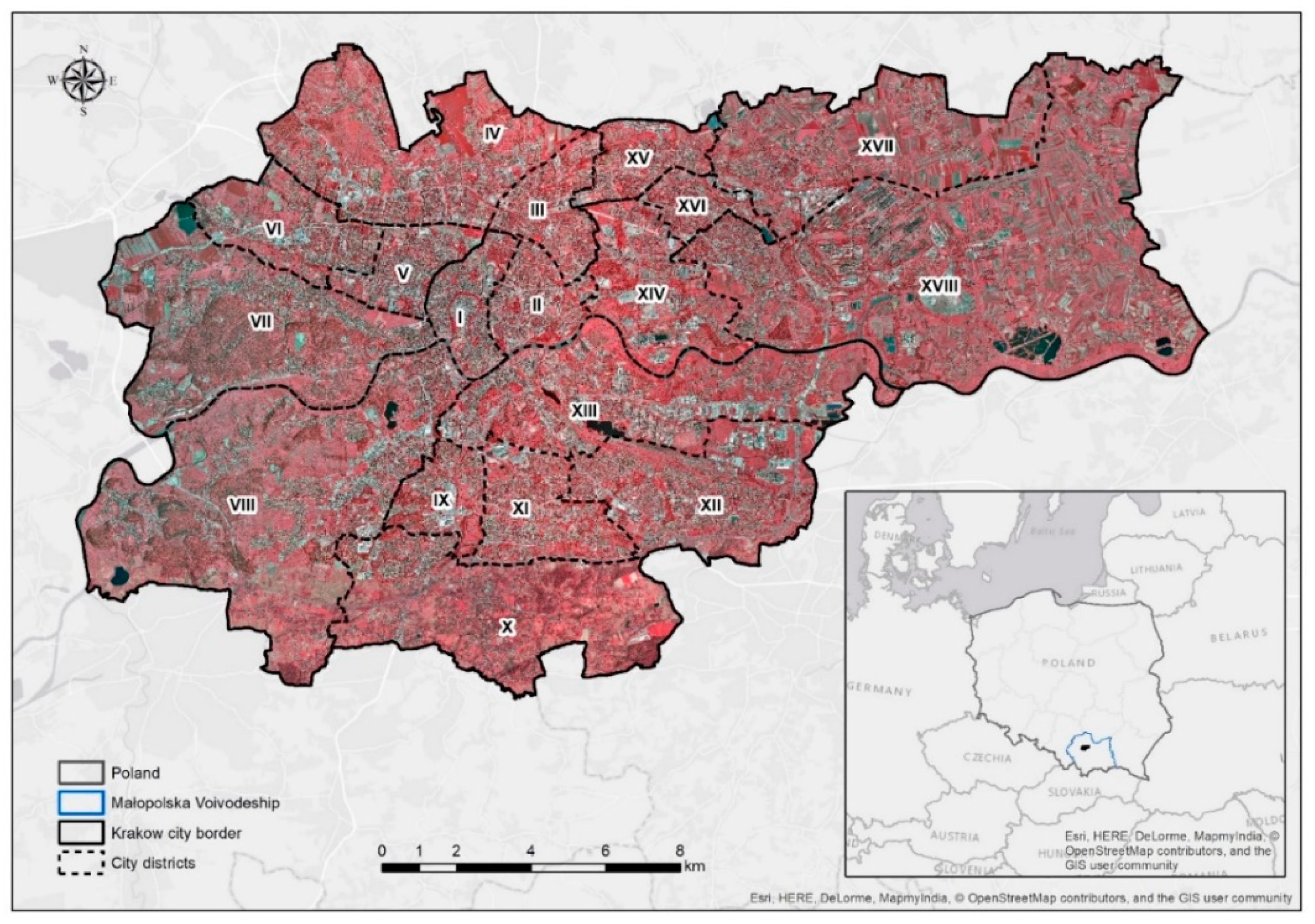


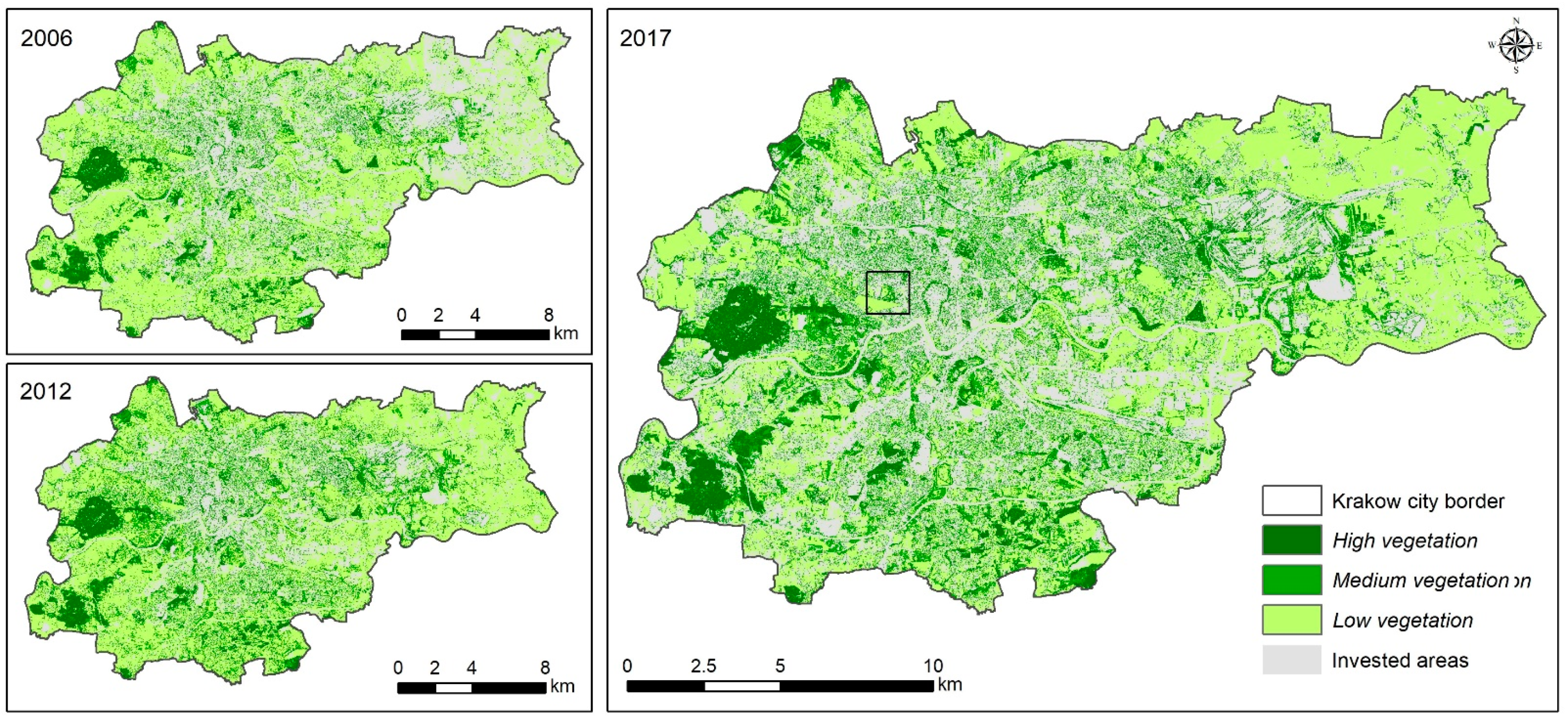
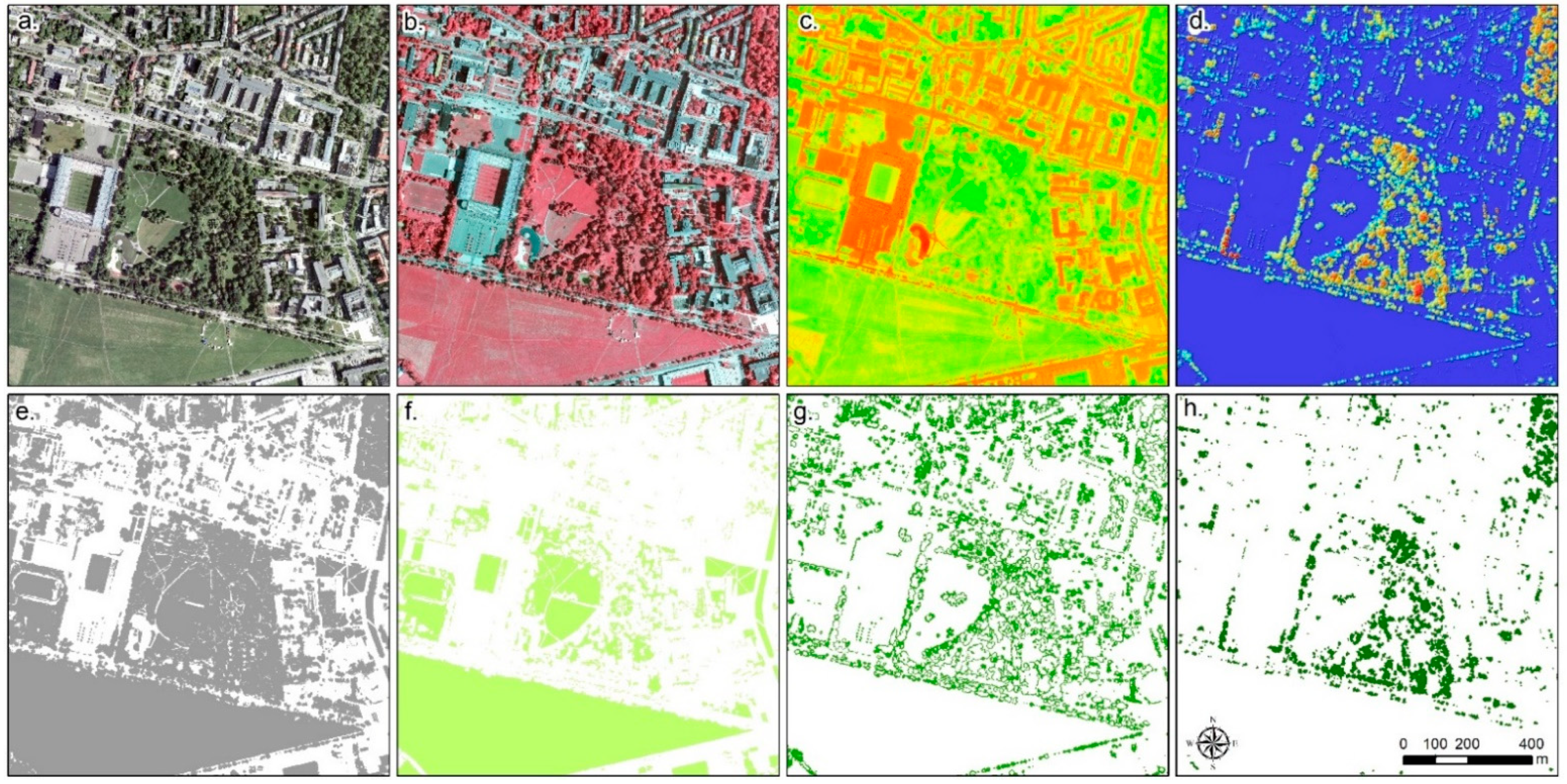

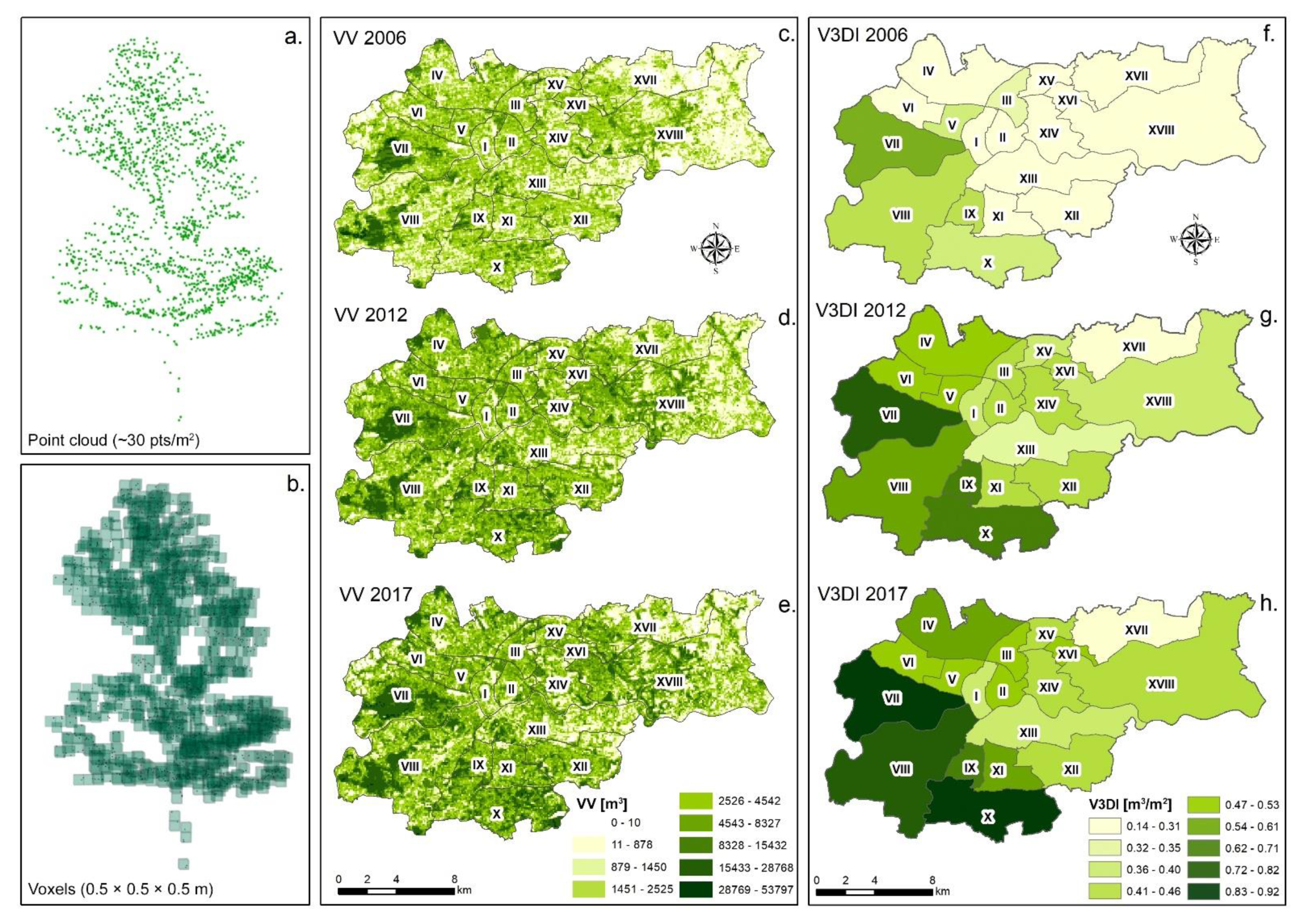
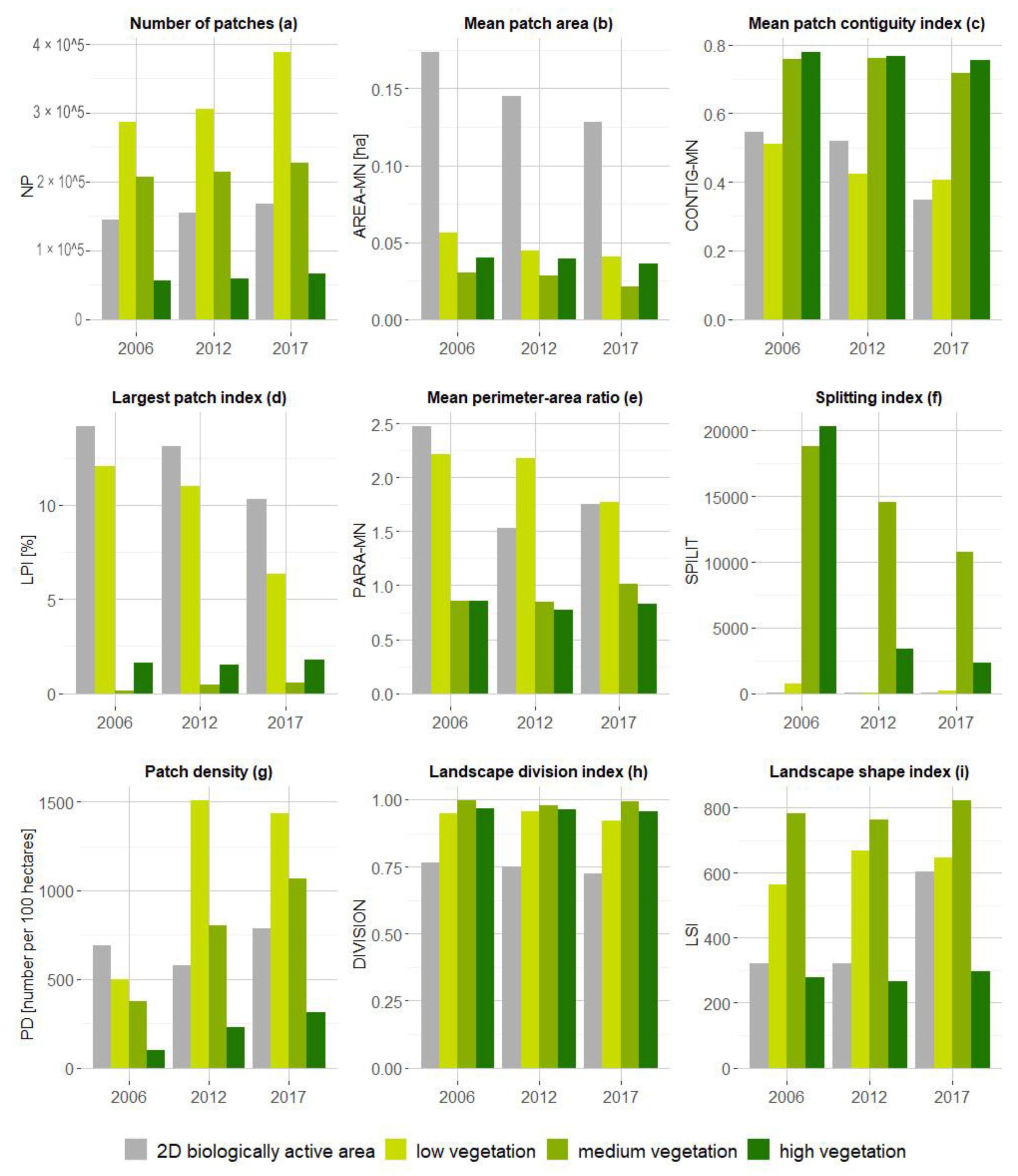
| Data Type | Data Acquisition Date | Resolution/ GSD * |
|---|---|---|
| ALS LiDAR point cloud 1 | November 2006 | ~12 pts/m2 |
| ALS LiDAR point cloud 2 | July 2012 | ~12 pts/m2 |
| ALS LiDAR point cloud 2 | November 2017 | ~12 pts/m2 |
| IKONOS-2 (SpaceImaging) 3 | June 2005 | 0.8 m PAN/3.2 m MS |
| QuickBird-2 (DigitalGlobe) 3 | September 2006 | 0.6 m PAN/2.4 m MS |
| WorldView-2 (DigitalGlobe) 3 | October 2014 | 0.5 m PAN/2.0 m MS |
| Aerial orthophoto (CIR) 2 | May 2017 | 0.25 m |
| LM Name | Abbreviation | Definition | Formula | Range | Unit |
|---|---|---|---|---|---|
| Number of Patches | NP | Number of patches in the landscape, or total number of patches for a class. NP describes the fragmentation of a class. | ≥1 | pcs | |
| Mean of Patch area | AREA_MN | The mean area of patches belonging to a certain class. | >0 | ha | |
| Mean Patch Contiguity Index | CONTIG_MN | Mean contiguity in patches per class. | 0 ≥ CONTIG_MN ≤ 1 | - | |
| Largest Patch Index | LPI | The area of the largest patch divided by the total area of the landscape multiplied by 100. | 0 < LPI ≤ 100 | % | |
| Mean Perimeter-Area Ratio | PARA_MN | The simple measure of shape complexity but without standardization to a simple Euclidean shape. | >0 | - | |
| Splitting Index | SPILIT | The number of patches obtained by dividing the area of the landscape into patches of equal size based on the effective network size. | 1 ≤ SPLIT ≤ Number of cells squared | - | |
| Effective Mesh Size | MESH | The total area of the patches of a given type, divided by the total number of possible connections between all the patches of the same type. | Cell size / total area ≤ MESH ≤ total area | ha | |
| Patch Density | PD | Number of patches per 100 ha. High density value translates into more fragmentation. | 0 < PD ≤ 1 × 106 | Number per 100 ha | |
| Landscape Division Index (Connectivity Index) | DIVISION | The fragmentation of a given class in the entire landscape. | 0 ≤ DIVISION < 1 | - | |
| Landscape Shape Index | LSI | The ratio between the actual landscape edge length and the hypothetical minimum edge length. | ≥1 | - |
| Vegetation Layers | Area | 2006 | 2012 | 2017 |
|---|---|---|---|---|
| 2D biologically active area (2D BAA) | [ha] | 24,872.4 | 24,110.4 | 23,655.0 |
| [%] | 76.1 | 73.8 | 72.4 | |
| Low vegetation (LV) | [ha] | 18,511.6 | 15,944.6 | 14,811.5 |
| [%] | 56.6 | 48.8 | 45.3 | |
| Medium vegetation (MV) | [ha] | 4597.7 | 6033.8 | 6454.8 |
| [%] | 14.1 | 18.5 | 19.8 | |
| High vegetation (HV) | [ha] | 1763.1 | 2132.0 | 2388.6 |
| [%] | 5.4 | 6.5 | 7.3 |
| Districts Name | District Area [m2] | 2006 VV [m3] | 2006 V3DI [m3/m2] | 2012 VV [m3] | 2012 V3DI [m3/m2] | 2017 VV [m3] | 2017 V3DI [m3/m2] |
|---|---|---|---|---|---|---|---|
| Stare Miasto (I) | 5,567,646 | 1,568,130 | 0.28 | 2,021,964 | 0.36 | 2,050,902 | 0.37 |
| Grzegórzki (II) | 5,845,232 | 1,753,833 | 0.30 | 2,595,643 | 0.44 | 2,757,026 | 0.47 |
| Prądnik Czerwony (III) | 6,437,857 | 2,172,132 | 0.34 | 2,937,814 | 0.46 | 3,412,039 | 0.53 |
| Prądnik Biały (IV) | 23,418,679 | 6,972,364 | 0.30 | 12,156,853 | 0.52 | 12,661,962 | 0.54 |
| Krowodrza (V) | 5,619,039 | 2,025,741 | 0.36 | 2,813,435 | 0.50 | 2,946,169 | 0.52 |
| Bronowice (VI) | 9,559,587 | 2,951,831 | 0.31 | 4,537,366 | 0.47 | 5,030,185 | 0.53 |
| Zwierzyniec (VII) | 28,730,964 | 15,435,958 | 0.54 | 22,345,381 | 0.78 | 26,498,908 | 0.92 |
| Dębniki (VIII) | 46,188,703 | 20,276,743 | 0.44 | 27,334,396 | 0.59 | 32,827,257 | 0.71 |
| Łagiewniki (IX) | 5,415,081 | 2,327,403 | 0.43 | 3,470,928 | 0.64 | 3,824,581 | 0.71 |
| Swoszowice (X) | 25,604,010 | 8,981,227 | 0.35 | 16,308,272 | 0.64 | 21,480,067 | 0.84 |
| Podgórze Duchackie (XI) | 9,540,011 | 2,361,502 | 0.25 | 4,176,972 | 0.44 | 5,209,664 | 0.55 |
| Bieżanów-Prokocim (XII) | 18,473,911 | 5,075,852 | 0.27 | 7,958,125 | 0.43 | 8,415,818 | 0.46 |
| Podgórze (XIII) | 25,667,082 | 5,818,538 | 0.23 | 8,358,587 | 0.33 | 9,151,215 | 0.36 |
| Czyżyny (XIV) | 12,256,767 | 3,125,468 | 0.25 | 5,142,518 | 0.42 | 5,382,160 | 0.44 |
| Mistrzejowice (XV) | 5,590,035 | 1,620,981 | 0.29 | 2,156,149 | 0.39 | 2,508,035 | 0.45 |
| Bieńczyce (XVI) | 3,699,023 | 1,075,666 | 0.29 | 1,625,709 | 0.44 | 1,863,929 | 0.50 |
| Wzgórza Krzesławickie (XVII) | 23,815,455 | 3,417,741 | 0.14 | 7,119,140 | 0.30 | 7,473,025 | 0.31 |
| Nowa Huta (XVIII) | 65,409,916 | 13,285,888 | 0.20 | 24,126,258 | 0.37 | 28,529,009 | 0.44 |
| Total | 326,838,998 | 100,246,997 | 0.31 | 157,185,509 | 0.48 | 182,021,949 | 0.56 |
| Landscape Metrics | Type of Vegetation | 2006 | 2012 | 2017 |
|---|---|---|---|---|
| NP | 2D BAA | 143,991 | 155,051 | 167,253 |
| LV | 286,285 | 305,321 | 388,438 | |
| MV | 206,191 | 214,456 | 227,464 | |
| HV | 55,658 | 59,382 | 66,489 | |
| AREA-MN | 2D BAA | 0.17 | 0.15 | 0.13 |
| LV | 0.06 | 0.04 | 0.04 | |
| MV | 0.03 | 0.03 | 0.02 | |
| HV | 0.04 | 0.04 | 0.04 | |
| CONTIG-MN | 2D BAA | 0.55 | 0.52 | 0.35 |
| LV | 0.51 | 0.42 | 0.41 | |
| MV | 0.76 | 0.76 | 0.72 | |
| HV | 0.78 | 0.77 | 0.76 | |
| LPI | 2D BAA | 14.20 | 13.10 | 10.30 |
| LV | 12.07 | 11.00 | 6.34 | |
| MV | 0.12 | 0.43 | 0.56 | |
| HV | 1.64 | 1.50 | 1.77 | |
| PARA-MN | 2D BAA | 2.48 | 1.53 | 1.75 |
| LV | 2.22 | 2.18 | 1.77 | |
| MV | 0.86 | 0.84 | 1.01 | |
| HV | 0.86 | 0.78 | 0.83 | |
| SPLIT | 2D BAA | 13.40 | 15.39 | 25.90 |
| LV | 728.00 | 41.10 | 167.00 | |
| MV | 18,782.00 | 14,600.00 | 10,734.00 | |
| HV | 20,377.00 | 3385.00 | 2326.00 | |
| MESH | 2D BAA | 1683.00 | 1387.00 | 822.00 |
| LV | 78.70 | 626.00 | 127.00 | |
| MV | 0.31 | 1.76 | 1.99 | |
| HV | 2.81 | 7.61 | 9.17 | |
| PD | 2D BAA | 690 | 575 | 784 |
| LV | 500 | 1509 | 1432 | |
| MV | 375 | 801 | 1067 | |
| HV | 97 | 231 | 312 | |
| DIVISION | 2D BAA | 0.77 | 0.75 | 0.72 |
| LV | 0.95 | 0.96 | 0.92 | |
| MV | 1.00 | 0.98 | 0.99 | |
| HV | 0.97 | 0.96 | 0.96 | |
| LSI | 2D BAA | 321 | 321 | 603 |
| LV | 563 | 669 | 645 | |
| MV | 782 | 764 | 823 | |
| HV | 277 | 266 | 298 |
Publisher’s Note: MDPI stays neutral with regard to jurisdictional claims in published maps and institutional affiliations. |
© 2022 by the authors. Licensee MDPI, Basel, Switzerland. This article is an open access article distributed under the terms and conditions of the Creative Commons Attribution (CC BY) license (https://creativecommons.org/licenses/by/4.0/).
Share and Cite
Zięba-Kulawik, K.; Wężyk, P. Monitoring 3D Changes in Urban Forests Using Landscape Metrics Analyses Based on Multi-Temporal Remote Sensing Data. Land 2022, 11, 883. https://doi.org/10.3390/land11060883
Zięba-Kulawik K, Wężyk P. Monitoring 3D Changes in Urban Forests Using Landscape Metrics Analyses Based on Multi-Temporal Remote Sensing Data. Land. 2022; 11(6):883. https://doi.org/10.3390/land11060883
Chicago/Turabian StyleZięba-Kulawik, Karolina, and Piotr Wężyk. 2022. "Monitoring 3D Changes in Urban Forests Using Landscape Metrics Analyses Based on Multi-Temporal Remote Sensing Data" Land 11, no. 6: 883. https://doi.org/10.3390/land11060883
APA StyleZięba-Kulawik, K., & Wężyk, P. (2022). Monitoring 3D Changes in Urban Forests Using Landscape Metrics Analyses Based on Multi-Temporal Remote Sensing Data. Land, 11(6), 883. https://doi.org/10.3390/land11060883







